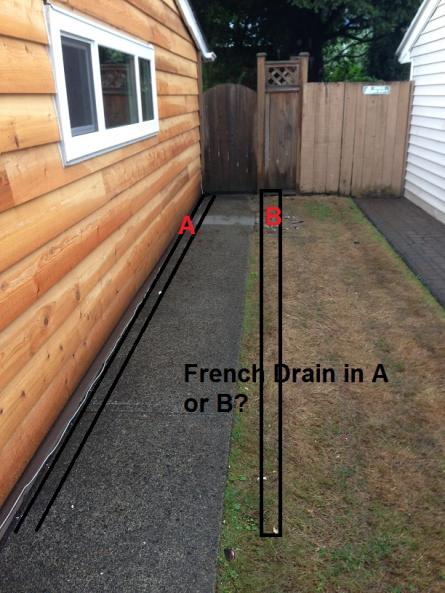If I understand your issue correctly, what you're calling a french drain may actually more properly be called a drywell. A french drain pulls in groundwater and moves it somewhere else, while a drywell is a place to get rid of water underground. I think what you're talking about is something to pipe your downspouts into, and therefore I'd call it a drywell.
That said, one can construct a drywell in a similar manner to a french drain, by digging a trench and filling it with gravel and a perforated drain pipe.
The key difference to understand, however, is that if what you really want is a drywell to get rid of water, it may need to be bigger than you think. The rainwater doesn't immediately disappear into the ground surrounding your drywell, you need to provide some storage space so that you can hold the water while it can slowly leeches into the ground.
You may want to quickly estimate how much water you need to deal with. Estimate the square footage of roof drained by these downspouts, and then multiply by a rainfall amount (some sources say look up a 5-year 24 hr rainfall amount for your area, other sources say simply use 1"), to get an estimate of the volume of water that could be flowing out of these downspouts. It adds up quickly!
If you simply dig a hole and fill it with crushed stone, you may need a big old hole, as crushed stone can have a void space of around 40%, so you'd need a hole 2.5 times bigger than your estimated roof runoff.
Therefore, you may want to consider an underground structure for your drywell, rather than simply filling a hole or trench with gravel.
One such product is made by NDS, called the Flo-well. It's a nice compact solution that can sometimes provide a good match for an individual downspout. You can stack them or daisy-chain them if you need more volume. Dig a hole, place the well, and backfill with gravel then topsoil. Simply plumb your downspouts into the drywell with PVC. The flo-well provides open space to hold lots of water, and has holes in its sides to allow the water out into the surrounding gravel and soil.


Or you could go with something even bigger if required, like some of the giant structures from Cultec that can hold up to 1200 Gal each, probably overkill for your application. These are like underground archways with open bottoms for the water to leech out of. Again, you'd dig a hole, lay a bed of gravel, place the chamber, and backfill with gravel then topsoil.

I have no affiliation with either of these suppliers, but have done some homework on this product space as I have a drainage issue of my own that needs solving on a tight, urban lot.
NOTE: If you are extra lucky and your property has some grade to it in just the right spot, it may be possible to simply run a pipe underground from the downspouts away from the house and have it come out the side of a hill to a place that you don't mind being flooded with rainwater. This is way simpler than a drywell. Just make sure to maintain positive drainage all along the pipe run (1/8" per foot or so).

image from www.askthebuilder.com








